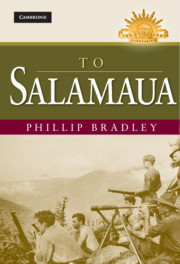Book contents
- Frontmatter
- Contents
- Foreword
- List of illustrations
- Acknowledgements
- Abbreviations
- Introduction
- 1 Death in the Bismarck Sea
- 2 Opposing forces
- 3 Warfe's tigers
- 4 Supply lines
- 5 Mubo stalemate
- 6 On Lababia Ridge
- 7 On Bobdubi Ridge
- 8 Yanks
- 9 Mubo falls
- 10 ‘A bit of a stoush’
- 11 The forbidden mountain
- 12 Roosevelt Ridge
- 13 Old Vickers
- 14 Komiatum Ridge
- 15 Across the Frisco
- 16 Salamaua falls
- Appendix: Place names
- Notes
- Bibliography
- Index
2 - Opposing forces
Published online by Cambridge University Press: 05 December 2013
- Frontmatter
- Contents
- Foreword
- List of illustrations
- Acknowledgements
- Abbreviations
- Introduction
- 1 Death in the Bismarck Sea
- 2 Opposing forces
- 3 Warfe's tigers
- 4 Supply lines
- 5 Mubo stalemate
- 6 On Lababia Ridge
- 7 On Bobdubi Ridge
- 8 Yanks
- 9 Mubo falls
- 10 ‘A bit of a stoush’
- 11 The forbidden mountain
- 12 Roosevelt Ridge
- 13 Old Vickers
- 14 Komiatum Ridge
- 15 Across the Frisco
- 16 Salamaua falls
- Appendix: Place names
- Notes
- Bibliography
- Index
Summary
The cornerstone of the Australian army in New Guinea was the brigade, composed of three battalions as well as brigade headquarters and specialised artillery, engineering and medical units. The infantry battalions deployed to New Guinea in 1943 utilised the new tropical-scale establishment of thirty-three officers and 753 other ranks. The battalion comprised four rifle companies, each of five officers and 127 men, and a headquarters company of six platoons: signals, machine-gun, mortar, tank attack, pioneer and administration. A regimental aid post was attached to each battalion. Each rifle company comprised a headquarters of fifteen men and three rifle platoons of thirty-nine men, made up of a six-man headquarters and three eleven-man infantry sections.
Each infantry section had one Bren gun, which was operated by two men, a number 1, who fired the gun, and a number 2, who carried and reloaded the magazines for the gun. A section had one or two submachine-guns, and these were normally carried by the forward scouts. Thompson submachine-guns were used in the early part of the campaign but were replaced by the Australian-designed Owen gun as they became available. The rest of the section was equipped with the tried and sturdy Lee Enfield .303 rifle, and on occasion a sniper's or grenade-discharging extra yoke version was made available. First-line ammunition was fifty rounds for the rifle, five Bren magazines, six Owen gun magazines and two grenades. These figures were generally doubled during an attack.
- Type
- Chapter
- Information
- To Salamaua , pp. 31 - 51Publisher: Cambridge University PressPrint publication year: 2010



